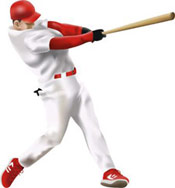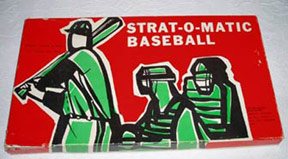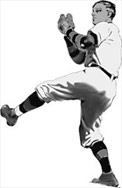|

Vol. IV,
Issue #2 - February 2016
**
The Marc Pelletier Challenge
Part II - The Pelleiter System
dealing with Pitchers
**
(This is the second part of several articles and reports that
will be made over the next few
months dealing with the Marc Pelletier System to draft teams in the
newly named on-line
SOM
Baseball 365 system for leagues using the 20XX
seasons plus the upcoming
utilization of the Pelletier System by Wolfman Shapiro as he
joins a 2015 season in March.)
(Comments from the Wolfman:
In our December 2015 issue, we introduced
to you one of the most successful on-line SOM Baseball gamers,
Marc Pelletier. Marc offered to share with our members a
discussion of how he creates his system to valuate
each player for the draft of the league or tournament he has
joined in order to decide which players he will select
for his team he will be playing using the 20XX year cards. So this
is his second article where he is fulfilling his promise to our
members. In our January issue (2016) he spoke about how to
evaluate the hitters for such a league/tournament, now in this
article he is discussing and focusing upon how to evaulate the
pitchers. If you missed the interview and first article by Marc
discussing his system, I have given you links below to those
pages:
http://www.ultimatestratbaseball.com/USBN-12-2015/MarcPelletier-December2015.htm
http://www.ultimatestratbaseball.com/USBN-1-2016/MarcPelletier-January2016.htm
In addition again, Marc accepted my challenge (as I did
with Bruce Foster last year to implement his system in an All
Time Greats on-line league I participate and won) to also learn and
implant his system as I plan to join a 2015 on-line draft season
for the newly named Baseball 365 which should be in March
sometime. So with this article, our readers should have a
good idea of Marc's total philosophies behind preparing his
system to play in these on-line leagues. The third part of
this article series that will be coming out next month (March)
will be a combined article I will write with Marc as he explains
his system to me and we prepare for my entry into a 2015 league
for Baseball 365. Of course, we are offering this type of extensive
interviewing and reporting with the hope that by following these
systems, it can help our members experience a greater degree of
success in their Baseball 365 game play for 2016.)
WAR in Straat
(The
Pelletier System for Pitchers)

Introduction
Last
month, I sketched the basis of a WAR-based evaluation system for
Strat (WAR=Wins Above Replacement level). In summary, WAR-strat
is determined by taking into account all contributions that you
can find on a Strat card:
(Offensive
Runs +
BaseRunning Runs + Fielding Runs + Positional Adjustment),
sum of
which must then be:
·
adjusted for the expected playing time of the player,
·
adjusted for the replacement level of your league,
·
and converted into wins.
I
argued that the best way to calculate the offensive runs a card
is expected to create is to base the rating system on linear
weights. I also argued that, instead of using linear weights as
generated by sabermetrics, we could generate our own weights
which would have the advantage of being adjusted for the rules
and environment of Strat (please refer
HERE
to read my last article and get more explanations on linear
weights, but in short, weights are roughly speaking to the run
value attributed to each event...)
Finally, I went to great length to explain how weights should
not be perceived as static. A run is a run is a run, but singles
are not created equal. A two-out single with bases loaded has
more weight than any other type of singles, so you would be
wrong to attribute the value of 0.47 (the average weight of a
single) to a clutch single — this is why many rating systems
that I’ve seen around in Strat typically underestimate the value
of clutch.
The
higher the scoring environment, the more valuable singles and
doubles are (the opposite is true in low-scoring environment)
and the reason for this is because the run expectancy related to
singles and doubles increases in a high-scoring environment ---
they have greater chances to produce runs. This explains why the
weights for clean-up hitters are usually higher than hitters at
the low end of a lineup --- they hit in a high-scoring
environment. This explains why on-base pays so much more in
Coors Field than in the Marlin's stadium whereas; I should add
that the value of homeruns is more constant throughout
environments: its value is always 1 run plus something (the
contribution of advancing runners), and while the value of that
“something” might fluctuate, since it can’t go lower than 1 run,
then it has less room to fluctuate. I’ll illustrate this effect
with an example shortly.
Scoring environment and pitching
I now turn to how should we best evaluate pitchers. The easier
way to measure the value of pitchers would certainly be to use
the very same linear weight formulas that we used for the
offense, multiply that by the chances that you have on the SOM
rating file that is based on the pitcher’s card, and finally
consider usage.
Consider Arrieta. Against left-handed hitters, his card only
allows 6 walks and 1.2 singles; everything else is made of outs
(leaving out K and gbA for now). If we use the weights that we
had for offense, (0.33 for walks, 0.47 for singles, -0.1 for
outs), Arrieta’s value vs lefties is = 6*0.33 + 1.2*0.47 –
70.8*0.1 =
-4.5.
This said, you might realize that what I wrote earlier about the
importance of considering the scoring environment will have an
important implication for evaluating the pitchers. Pitchers are
among the greatest contributors of settling a high-scoring or
low-scoring environment. A bad pitcher who allows a lot of
on-base creates a high-scoring environment by himself, whereas
Arrieta's card creates a low-scoring environment with such low
on-base chances that are on his card. So if an average single
has the weight of 0.47, what weight should we use for Arrieta?
Surely lower, but how much lower? 0.40?
But on the surface, it sure looks like a better rating system
for pitchers should assign to each pitcher its proper linear
weights generated by the scoring environment the pitcher
creates. While this looks like an impossible mission, in fact,
it can done relatively easy thanks to the availability of Excel
files that integrate a mathematical function called Markov
chain. The most accessible file I found is one created by Steve
Staude, on fangraphs, which you can download here:
http://www.fangraphs.com/blogs/team-specific-hitter-values-by-markov/.
In fact, this spreadsheet is capable of not only generating
specific linear weights for each pitcher, but it can also
generate for each pitcher the (Markov) Expected Runs per game
which can more or less be interpreted as the expected ERA.
However, the downside of using this approach is that it works
properly only if you project the ratings of a pitcher on 216
plate appearances --- so you need to estimate what a typical
offense (in your league) will do in 108 chances, what a typical
defense will allow on the 30 chances found on the X-chart, and
add those value to the ratings that reflect the pitcher’s card.
I did this exercise with the new 2015 rating file. Here is the
output for two pitchers, the 2015 ace Arrieta and journeyman
Feldman:
|
Team or Player |
Linear Weights
(derived from Markov) |
|
|
BB (or HBP) |
1B |
2B |
3B |
HR |
Outs |
RA-adj |
|
Feldman,S |
0.45 |
0.57 |
0.86 |
1.12 |
1.48 |
-0.40 |
6.70 |
|
Arrieta,J |
0.30 |
0.41 |
0.69 |
0.98 |
1.45 |
-0.20 |
3.13 |
As you see, the linear weights vary greatly between the two
pitchers, except for homeruns which are relatively similar.
Since the spreadsheet already does the job for me of using the
linear weights to estimate the ERA, I only needed to perform
additional adjustment to take in consideration gbA, steals/cs,
and defensive value, in order to get the full value of a
pitcher’s card. The (earned and unearned) RA-adjusted that you
find in the table is the end result of the process (in the case
above, the average I used is estimated for a 12-team league with
80 Million to spend).
--------
( Editor's
Note:
In Baseball 365, if you are not familiar with how their leagues
work it goes as follows -- you are allocated so much money to
spend to build your team. Each player is given by Strat a
monetary value. Obviously MVP players Bryce Harper and Josh
Donaldson (along with Mike Trout) as hitters and pitchers like
Jake Arrieta, Clayton Kershaw, Zack Greinke and Dallas Keuschel,
are going to players with the highest salaries {and lets not
forget Wade Davis in relief}. So you must draft at least 25
players and you can keep up to 28 players, or hold a minimum of
24 players with a stadium that equals a collective salary of 80
million or less. Obviously if you go for a few players with high
salaries you won't have much to spend to fill out your team.)
--------
Here is the top value for SP and RP (based on a neutral stadium,
this is based on RA-adjusted, and not WAR, which must
integrate usage, the WAR rankings will come later):
|
TOP LEFTY SP |
|
TOP RIGHTY SP |
|
Hill,R* |
2.67 |
|
Arrieta,J |
3.13 |
|
Kershaw,C* |
3.36 |
|
Greinke,Z |
3.18 |
|
Keuchel,D* |
3.87 |
|
Degrom,J |
3.63 |
|
Garcia,J* |
4.07 |
|
Gray,S |
3.99 |
|
Price,D* |
4.42 |
|
Harvey,M |
4.13 |
|
Sale,C* |
4.43 |
|
Cole,G |
4.25 |
|
Bumgarner,M* |
4.55 |
|
Verrett,L |
4.25 |
|
Matz,S* |
4.86 |
|
Stroman,M |
4.25 |
|
Hamels,C* |
5.11 |
|
Scherzer,M |
4.30 |
|
Liriano,F* |
5.20 |
|
Tomlin,J |
4.58 |
|
Lester,J* |
5.35 |
|
Hahn,J |
4.61 |
|
Pomeranz,D* |
5.35 |
|
Wainwright,A |
4.61 |
|
Wood,T* |
5.37 |
|
Estrada,M |
4.74 |
|
Santiago,H* |
5.40 |
|
Tanaka,M |
4.83 |
|
Heaney,A* |
5.41 |
|
Davies,Z |
4.83 |
|
TOP RELIEVERS |
|
Syndergaard,N |
4.83 |
|
Davis,W |
2.67 |
|
Archer,C |
4.84 |
|
Miller,A* |
3.23 |
|
Eickhoff,J |
4.89 |
|
Jansen,K |
3.25 |
|
Duffey,T |
4.89 |
|
Capps,C |
3.25 |
|
Iwakuma,H |
4.92 |
|
Melancon,M |
3.33 |
|
Ramirez,E |
4.97 |
|
Watson,T* |
3.34 |
|
Kluber,C |
4.99 |
|
Givens,M |
3.36 |
|
Cueto,J |
5.01 |
|
Familia,J |
3.41 |
|
Warren,A |
5.02 |
|
Strickland,H |
3.46 |
|
Carrasco,C |
5.04 |
|
Rodriguez,F |
3.46 |
|
Buchholz,C |
5.06 |
|
McGee,J* |
3.47 |
|
Lackey,J |
5.06 |
|
Manship,J |
3.48 |
|
Verlander,J |
5.08 |
|
Harris,W |
3.49 |
|
Morrow,B |
5.11 |
|
Uehara,K |
3.52 |
|
Gonzalez,C |
5.14 |
|
Robertson,D |
3.54 |
|
Salazar,D |
5.20 |
|
Strop,P |
3.55 |
|
Strasburg,S |
5.23 |
|
Ziegler,B |
3.57 |
|
Wacha,M |
5.25 |
|
O'Day,D |
3.59 |
|
Young,C |
5.35 |
|
Goeddel,E |
3.64 |
|
Anderson,C |
5.38 |
|
Smith,C |
3.70 |
|
Hernandez,F |
5.39 |
|
Betances,D |
3.71 |
|
Heaney,A* |
5.41 |
|
Siegrist,K* |
3.71 |
|
Hendricks,K |
5.41 |
|
Hinojosa,D |
3.75 |
|
McCullers,L |
5.43 |
|
Britton,Z* |
3.80 |
|
Blanton,J |
5.43 |
The
numbers appear high, but they include both earned and unearned
runs (defensive miscues coming from an average defense were
included as hits allowed).
When I compare this ranking with the one obtained more
traditionally, using the same weights for all pitchers (e.g.
0.47 for singles), the changes are more subtle than I expected.
Most pitchers change rank by one or two spots. The impact is
more important for only a few pitchers. The biggest “loser”
among the potential top 50 starters is Texas’ C. Gonzalez, who
goes form 32nd on the traditional ranking to 39th (that’s
roughly equivalent to losing 0.15---going from 5.00 to 5.15).
Among relievers, the impact is slightly more important: Brewers’
Rodriguez falls back to the 10th best card and Houston’s Harris
to 13th best card---losing both 5 positions. Garrett Cole is a
beneficiary of the new ranking, so in his case, it might be
explained by the combination of a great gbA numbers and the
relatively higher on-base as compared to pitchers of a similar
value.
Pitchers usage
Those rankings I shared above are solely based on the value of
the card (supplied by league average), but they don’t consider
usage. A 2-inning reliever who can close might provide more
value (and get a better WAR estimate) compared to a 1-inning
reliever with a better card.
--------
( Editor's
Note:
In the next part of this section, Marc discusses how many
innings the starting pitchers might pitch in a Baseball 365
League and you will see very high numbers of innings. This
is because in Baseball 365, how much a hitter or pitcher is used
is not based on their actual usage as is utilized by most
face-to-face or computer based leagues, but how good their card
is and assuming they are not injured - for starting pitchers in
Baseball 365 if they are injured, its usually for the game and
they don't miss a start, so please keep this rule how pitchers
are used in the on-line game when you see the innings listed in
the table below. The same is true for relievers who based
on an "R" rating given by SOM are able to pitch a fantastic
amount of innings as well. Some teams have won their league with
a reliever with a great card going 200 innings!)
--------
Usage is in part influenced by the endurance rating of the
pitcher. A 7-inning starter (S7) is likely to pitch more than a
6-inning starter (S6). This said, usage is also determined by
the quality of the pitcher. Pitchers who allow a lot of on-base
are more likely to reach their fatigue point (or induce the
countdown of the SADV {Super Advanced} fatigue system in the
online game), which will limit the number of innings pitched.
Slugging can also have an impact, especially in inducing fatigue
based on the 5-run inning ruling. And of course, if you play
with the same rules as the online game, so-called “star”
pitchers will have more starts than “regular” starters. Taking
all together, Arrieta is the pitcher expected to pitch on
average the highest number of innings with 330 innings:
|
Starting pitchers |
|
S(7*) |
From Arrieta (330 innings) to Samardzija (276
innings) |
|
S(6*) |
From Gray (274 innings) to Teheran (224
innings) |
|
S(7) |
From R. Hill (271 innings) to E. Santana (212
innings) |
|
S(6) |
Degorm (228 innings) to several at 150
innings |
Relievers also have an endurance rating (form R4 to R1) which
will influence the number of non-fatigued expected innings, and
they have a closer rating, which allows more opportunities (in
the 9th inning to pitch in non-fatigued mode). I
should add that these inning estimates are useful only if you
can estimate how many innings are squared in 216 plate
appearances. Since the usage rules in the on-line game are
rather relax, there are 10 relievers who are expected to pitch
160 innings or more:
|
Relievers expected to pitch over 160 non-fatigued
innings (online game) |
|
Villanueva,C (R3) |
174 |
Uehara,K (1) |
162 |
|
Schultz,B (R3) |
169 |
Rivero,F* (2) |
162 |
|
Jansen,K (R1) |
167 |
Goeddel,E (2) |
162 |
|
Givens,M (R2) |
164 |
Davis,W (1) |
161 |
|
Rodriguez,F (R1) |
163 |
Petit,Y (3) |
160 |
Leverage index
A final issue that can have an impact on WAR is the leverage
index (LI), which is an attempt to quantify the probability that
a reliever is used in games that count rather uselessness
situations. Closers and set-up men are usually more involved in
tight situations compared to a 7th or 8th reliever who job is to
mop-up situations. In real-life baseball, by definition,
starting pitchers have a 1.00 leverage index, closers have a LI
between 1.75 to 2.2 and set-up men have a LI an index around
1.5. The net impact is important: if a reliever saves 20 runs
per year compared to replacement player, and his leverage index
is 1.5, the net impact will be closer to 30 runs (20 X 1.5),
although I must add that, as I write this, I am still trying
different solutions to make sure I don’t overestimate by this
index the impact of relievers. I kinda believe that relievers
that can throw up to 150 innings are probably throwing in more
useless innings compared to real-life set-up men and closers who
are limited to 60-70 innings.
Conclusion
You’ll find below a provisional account of the top WAR for
pitchers. As I am still struggling to incorporate accurately the
value of relievers, I prefer for now to keep the WAR estimation
separately for starting pitchers and relievers with the WAR for
relievers are probably overestimated. This being said, it is
obvious that the online game allows the exploitation of the
super-reliever strategy and there is no doubt that this strategy
is successful. So I’m leaning towards thinking that the WAR
estimation for super-relievers might not be far from reality.
Perhaps this is a platitude, but you should bear in mind that
these WAR values don’t add up within a team. If you pick up 4
super-relievers who's worth is above a value of 3 WAR, your team
won’t get 12 extra wins, since a few of those super-relievers
will mostly be involved in games with low leverage, doing a
mop-up role. The WAR estimation with regards to relievers is
closely linked to the specific roles of a closer and the set-up
man. It represents more a potential rather than an actual
prediction. Of course, if you play the online game, you must
also control with sufficient ease the bullpen settings to have
the proper pitcher play the role you have planned. The
interaction between the right bullpen and the rotation must also
be considered.
Furthermore, I should repeat something I wrote in the last
article, which is that, although my ratings could be adapted for
any kind of league, they are definitively set for the 80 Million
on-line game. This is clearly apparent in the high ranking of
lefty pitchers. In the 80 Million on-line game, expensive lefty
crushers are most often left on the bench as Strat players feel
that they don’t play enough to justify their salary. As a
consequence, the league average vs lhp is almost equivalent to
the league average vs rhp. In face-to-face leagues with no
salary restrictions, league average vs lhp is usually better
than league average vs rhp, and this lowers the value of lefty
starters.
There are several issues I didn’t talk about which are more
technical: how to estimate the impact of holding, balks and wild
pitches, which could take several paragraphs; plus, in the
process of estimating WAR, how to go from a system based on 216
PA to a system based on innings pitched (the transition is more
complicated than it seems). As I intend in the future to make
available my spreadsheet with a full example of a player and a
pitcher being evaluated, these details may be provided to whom
it may be of interest.
Provisional ranking of pitchers by WAR (usage included)
|
Starting pitchers WAR |
Relievers
WAR |
|
Arrieta,J |
8.39 |
Davis,W |
5.90 |
|
Hill,R* |
7.91 |
Jansen,K |
4.96 |
|
Greinke,Z |
7.73 |
Miller,A* |
4.72 |
|
Kershaw,C* |
7.04 |
Melancon,M |
4.45 |
|
Keuchel,D* |
4.93 |
Rodriguez,F |
4.33 |
|
Degrom,J |
4.23 |
Familia,J |
4.27 |
|
Gray,S |
3.97 |
Uehara,K |
4.16 |
|
Scherzer,M |
3.53 |
Robertson,D |
3.88 |
|
Cole,G |
3.53 |
Ziegler,B |
3.77 |
|
Sale,C* |
2.98 |
McGee,J* |
3.44 |
|
Price,D* |
2.96 |
Britton,Z* |
3.20 |
|
Stroman,M |
2.88 |
Givens,M |
3.19 |
|
Garcia,J* |
2.87 |
Harris,W |
3.06 |
|
Harvey,M |
2.83 |
Strop,P |
3.03 |
|
Bumgarner,M* |
2.51 |
Kimbrel,C |
2.98 |
|
Verrett,L |
2.26 |
Smith,C |
2.96 |
|
Tomlin,J |
1.79 |
Osuna,R |
2.93 |
|
Wainwright,A |
1.59 |
O'Day,D |
2.91 |
|
Hahn,J |
1.55 |
Watson,T* |
2.90 |
|
Archer,C |
1.31 |
Manship,J |
2.88 |
|
Estrada,M |
1.28 |
Betances,D |
2.83 |
|
Tanaka,M |
1.12 |
Capps,C |
2.80 |
|
Syndergaard,N |
1.09 |
Gregerson,L |
2.71 |
|
Eickhoff,J |
1.08 |
Goeddel,E |
2.69 |
|
Kluber,C |
1.01 |
Rondon,H |
2.65 |
|
Davies,Z |
1.00 |
Siegrist,K* |
2.64 |
|
Matz,S* |
0.99 |
Cecil,B* |
2.51 |
|
Cueto,J |
0.94 |
Strickland,H |
2.47 |
|
Duffey,T |
0.88 |
Hinojosa,D |
2.31 |
|
Iwakuma,H |
0.87 |
Benoit,J |
2.25 |
(Note, while I don’t expect the rankings above to be changed,
the scale on which WAR is based might evolve more ...)
Marc Pelletier
If any members of our newsletter
would like to speak to Marc directly, you can reach him at his
email at:
-----------------------
Stay tuned to Part III of this article discussing
the Marc Pelletier system as Marc guides me into Pelletier Land
as I work with him to prepare for my entry in March into a
Baseball 365 league based upon the new 2015 MLB card set.
Obviously he has shared part of his ranking system here in this
article explaining to you how he evaluates the various pitchers
that we are able to draft for these leagues (and their crazy
usage rules). Next month I will share my thoughts as I learn his
system and what team I was able to draft for the league I joined
based upon his evaluation of the available players. I am
very excited to see what will happen next, aren't you?
Wolfman
|
Support the Cause
If you are enjoying
the content and information our newsletter shares with you, why
not support us with your helpful donation for our minor expenses
and time?
|
Contained inside this exciting issue of
Ultimate Strat
Baseball Newsletter:
(to view the various interviews, articles, columns and special sections click on
the links {underlined}
and this will take you to the appropriate
webpage)
♦
RETURN TO NEWSLETTER MAIN PAGE
♦
INTERVIEW with WILLIE MAYS AIKENS,
we return with our 2nd interview with ex-Major Leaguer, Willie
Mays Aikens, known for being a member of the KC Royals when they
went to the World Series with George Brett in the 1980's.
We ask Mr. Aiken some new questions and his experience as a
hitting coach for the players in the KC Royals minors.
♦
STRAT WISE with MARC WASSERMAN
--
commissioner of the Cyber Baseball Association (CBA) continues
his new column sharing various perspectives on SOM
Baseball. In this issue he discusses about his visit on "Opening
Day", the top 20 cards in the 2015 MLB set and some special
new videos on our Video Channel on Youtube.
♦
ARTICLE with CHUCK TINKLER (Part III) , a continuation
of the article by Chuck, one of our members sharing about a
real Strat Master that he met in his early days of playing Strat-o-matic
♦
SOM BASEBALL LEAGUE REPORT with WOLFMAN SHAPIRO
--
the editor of "The Ultimate Strat Newsletter" and 2012 CBA
Champion, the "Wolfman" puts out a call to
the members of various Strat-o-matic Baseball Leagues that he
has discovered on the internet to talk about their experiences
with their league. This is the first time we get to speak to a
League Champion, from NASOMA, who we spoke to their commissioner
in our December 2015 issue.
To read his interview, click on the link below:
INTERVIEW with Rick
Lackey, NASOMA 2015 Champ, P-I (F2F/Netplay/Computer)
♦
SOM/MAJOR
LEAGUE BASEBALL WORLD NEWS with WOLFMAN SHAPIRO
, editor of "The Ultimate Strat Newsletter"
shares two live reports from Strat-o-matic's Opening Day on
February 12th, and introduces you to the Strat Tournament
Players Club (STPC) Reporters who starting in March will be
sharing with us the latest news and insights from this year's
series of grueling and testing tournaments this year. Also
STPC and this newsletter are announcing a test tournament you
can join us - we are seeking members to help us. To read
more, visit this latest version of our newsy page.
♦
INTERVIEW with Jim Gary, he is the head of the West
Region of the Strat Tournament Player's Club (STPC) and is on
their council. This is our second time to speak to Jim. For 2015
he was the points champion of the club so we inquiry to the keys
to his success. It is our goal in this year to interview all the
STPC council members as well as begin to share reports of what
is happening in their world.
♦
RECOMMEND
ON-LINE SOM RESOURCES
--
On-line Strat-o-matic and Baseball related websites
that offer amazing information, special tools and products to improve
your game play
that we strongly recommend. In most cases, we have had personal contact with
these sources who agree with the principle to work together and help promote each other.
♦
BOOKS TO
DIE FOR and Become a BASEBALL GURU
-- This page
is
specifically about special books we are finding that either will
expand your insights about the game of Baseball, help you in the
creation of your current league teams or with your replays and
learn more about the Strat-o-matic
Baseball Game and Game Company's
history. We
have a special arrangement with Acta Sports, who is a publisher
of a number of great baseball books (including Bill James
Handbooks) to offer for our members
a 10% discount. We will continue to add more books to this page in the future
as we uncover other gems our members should know about.
Contact Us for Questions or Submissions:
Wolfman Shapiro
Founder/Editor, the
Ultimate Strat Baseball Newsletter
email:
wolfman@ultimatestratbaseball.com
facebook:
www.facebook.com/wolfman.shapiro
twitter:
@StratBaseball4U
To Sign Up and Become a Member of this Newsletter
http://www.UltimateStratBaseball.com
(this provides direct emails when our bulletins
and next
issues come out)
|
|




